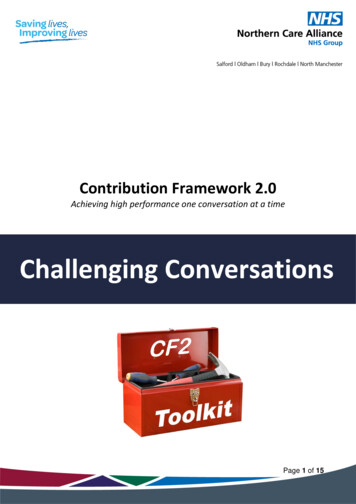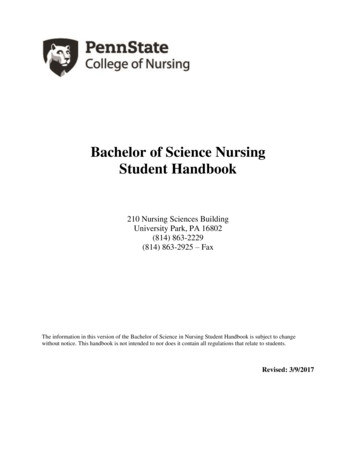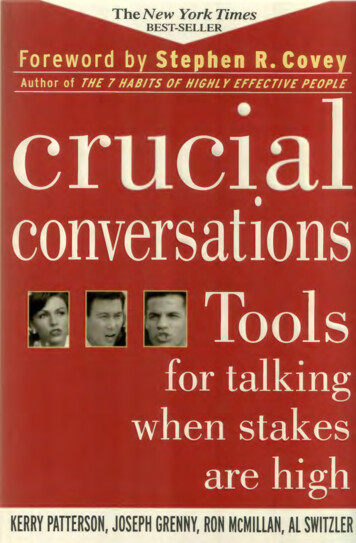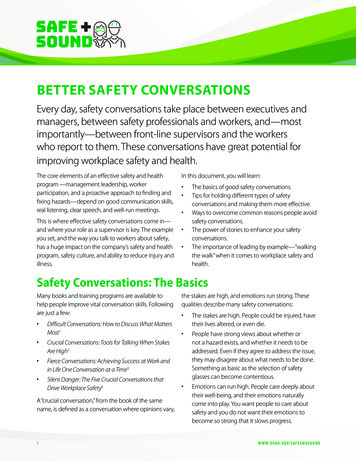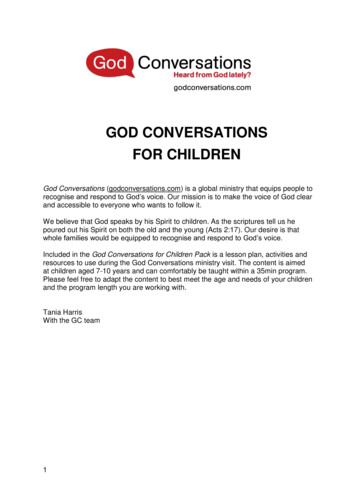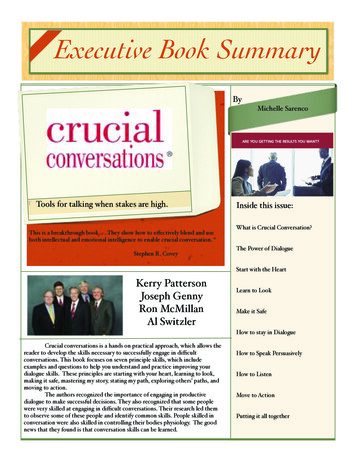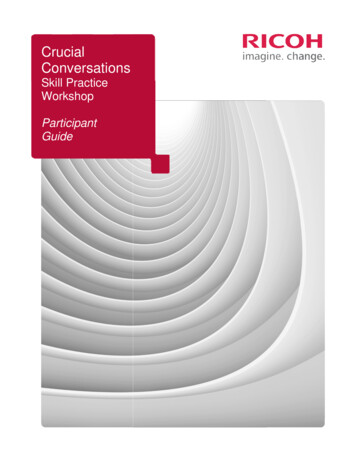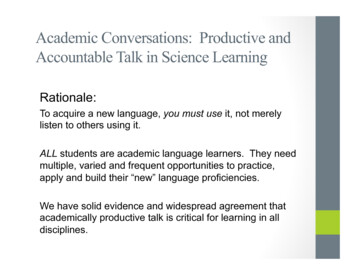
Transcription
Academic Conversations: Productive andAccountable Talk in Science LearningRationale:To acquire a new language, you must use it, not merelylisten to others using it.ALL students are academic language learners. They needmultiple, varied and frequent opportunities to practice,apply and build their “new” language proficiencies.We have solid evidence and widespread agreement thatacademically productive talk is critical for learning in alldisciplines.
The BenefitsProductive and Accountable Student Conversations Foster: meaning negotiation, idea building and problem-solving develops cognition and critical thinking skills (building,shaping and challenging ideas) and supports “focusingstamina” Expands vocabulary Builds skills that transfer into literacy skills Oral language development leads to better readingcomprehension: More complex aspects of oral language, including syntaxor grammar, complex measures of vocabulary (such asthose in which children actually define or explain wordmeanings), and listening comprehension were clearlyrelated to later reading comprehension (National EarlyLiteracy Panel, 2008)
And yet .To develop deep and enduring academic language,thinking skills, and content understandings, we need tocreate classroom contexts that go beyond “the norm”: Interrogation (IRE), Regurgitation, Little wait timeOver Reliance on Sentence starters and FramesQuantity rather than quality (Pair-shares)Group & whole class discussions in which a few students& the teacher dominate the talk Narrow assessment practices (written, MC) Isolated & disconnected facts & vocabulary
Experiential EvidenceBatteries and Bulbs lesson Simulation Provided an example of a sciencelesson with literacy and dialoguestrategies integrated throughout. Provided a model of engaging scienceand a sample of teacher talk thatencourages student engagement. Gave you some ideas for insertingstrategies that address Common Corestandards (S&L, R, W) and engagingscience strategies into your lessons.
Deconstructing the eadingMeaningfulWritingContext in reallife patory set(A&D) toactivate priorknowledgeRules PairShareInformationaltextArguments withevidenceI do one, you dooneParaphrasePassportText-basedevidenceWriting to learnas well asformal writing
Common Core StandardsSpeaking and Listening Anchor StandardsComprehension and Collaboration!Preparefor and participate effectively in a range of conversations andcollaborations with diverse partners, building on others’ ideas and expressing theirown clearly and persuasively.!Integrateand evaluate information presented in diverse media and formats,including visually, quantitatively, and orally.!Evaluatea speakers’ point of view, reasoning, and use of evidence and rhetoric.Presentation of Knowledge and Ideas!Presentinformation, findings, and supporting evidence such that listeners canfollow the line of reasoning and the organization, development, and style areappropriate, to task, purpose, and audience.!Makestrategic use of digital media and visual displays of data to expressinformation and enhance understanding of presentation.!Adaptspeech to a variety of contexts and communicative teaks, demonstratingcommand of formal English when indicted or appropriate.
The New CCSS AND ELD Standards:A Broader View of Classroom Language, Disciplinary Practices andLanguage Functions Moving from language as structures and/orfunctions to “language practices” Language-embedded practices occuracross the curriculum (math, science, ELA,etc.) ALL STUDENTS, including Englishlearners, must be able to engage inlanguage practices across the curriculum tomeet CCSS & NGSS.
What might “it” look like?Discussion By DesignYou’ve seen it/experienced it yesterdayam: Give students’ a purpose (controversyhelps)—ask a real question. Leverage the type of thinking you want(but not the answers you want). Create situations where the students’ideas will build on each other. Afterwards, ask for reflection.
Structured Discussion 1 & 2 discuss while 3 & 4 takes notes in a Tchart. 3 summarizes and then asks for elaborationor clarification on one underdeveloped butimportant point AND joins the conversationwhile 4 continues to take notes in a 3-chart. 4 gives credit to individuals for significantideas and synthesizes work of the group intoa short statement. Each person comments on the implicationsfor teachers.
You and I, in fact everyone all over theworld, we are all literally African under theskin. Brothers and sisters separated by amere 2,000 generations. Old fashionconcepts of race are not only sociallydivisive, but scientifically wrong. It’s onlywhen we’ve fully taken this onboard thatwe can say with any conviction that thejourney our ancestors launched all thoseyears ago, is complete.- Spencer Wells
Talk Happens:Classroom Structure/ Participant Structure Whole class Individual work Partner work/ dyads Small group seatwork Collaborative work/ cooperative learning Complex Instruction Long-term group projects (e.g., GroupInvestigation)
Match between learning task andclassroom structure Effective pedagogy maximizesthe match between features ofthe learning task andparticipant structures
DesigningGroup-worthyTasksEqualizingParticipation &AccessManagingGroupworkBuildingEquitable ClassroomsDevelopingAcademic LanguageAssessingStudent Workin Groups
In order to prepare students to engage inLanguage practices, teachers must identifythe Language Demands of a lesson Language demands describe the language students need inorder to be successful at a certain lesson or series of lessonsacross communicative modes Demands of sample science text (reading, writing) Demands of oral language (listening and speaking) For example, students may need to control certain types oflanguage practices in order to achieve the objectives of alesson(explanation, evaluation, argument, summarize,synthesize)
Aims of Academic ConversationTo get somewhere.
Conversation skillsMany dialogue protocols to choose from (see Using DialogueProtocols) but .Teachers must “teach” these participatory structures using thegradual release of responsibility model-Model-Guided Practice-Cooperative o list lecture components/6733/lecture videos/2760S1. Lecture Videos S1-6. Course Overview Screencast (WelcomeVideo) .17- 3.53, 6.18- 11.53
Turn and Talk Why would the conversations that usethe conversation skills (turns build onprevious turns, turns focus on lessonobjectives) help students be betterthinkers, speakers and writers thanthe “non-example” conversations?
Oral language development:What does it sound like when students engage with us andeach other in productive ways during discussions?! Examine the Conversation Analysis Tool- turnto the person next to you- any questions aboutit?! Score the Middle School Conversation Sample! Compare scores
HS Sample
Teaching Conversation Skills- The How ToKey Ingredients for ConstructiveConversations: authentic purpose clear prompt original language sufficient content knowledgeTeachers must model and teach specific skillsin order for students to engage in high qualityconversationsS2. Lecture Videos S2-3. Teaching Conversation Skills (Slidecast)What’s Missing? 3:30-10:06
Getting Conversation Work Started1) One skill at a time2) Use familiar content3) Model each skill4) Provide plenty of practice5) Formatively and self-assessthe skills
Video Example In this clip, students had read an article on whether or notpizza should be given as a reward for reading. They hadalready worked with the 3-D Argument Scalemanipulatives in previous lessons. The focus of thisactivity was to come up with reason and evidence cardsand evaluate their "weight" on each side of the argument.S2-5 Paired Student Conversations 0-1:59, 3:35, 6:52
Watch for the following: Ways in which the teacher pushes studentsto clarify ideas and use academic languageto compare their "weights" How students use the manipulative scales tosupport their conversations Possible next steps that the teacher couldtake based on the conversation workobserved
Your Turn to Try it!Practice learning and using these same skills so you canexperience what it feels like!Research shows that in preservice and inserviceeducation, if the participants do not get to use the targetskills themselves they rarely apply them in their practice
Part 1: Read-Hookworms?!Create a partnership!Create a group of four!Pair one: Read!Pair two: Read
Part 2: Discuss!1) Discusswith your partner- use yourCCS- the main causes and effects asoutlined in the article2) Decide which two-three were the mostvaluable and conversation-worthy, andrank them. Fill out the Cause and Effectgraphic organizer3) Have a conversation, in your pair, usingthe text and graphic organizer. Use your“create,” “clarify,” and “fortify” CCS.Practice making yourself as clear aspossible. Take notes on what your partnersays if you wish.
Part 2: Discuss!, cont. 4) Switch partners and have a second conversation,without the visual organizer or text, or notes. Talk aboutyour conversation with your last partner. Use your CCSin your conversation. Extension- Modeling: Language of Negotiation 5) Join another pair. In your new group of four, switchthe focus of the conversation to argument. Based onyour reading of the article, address the following:“Is the doctor’s act of self-infecting himself in the interestof “science” ethical? Focus on your CCS negotiating skills (may still useclarify, build and create)
How can you develop your students’ movement along theoral to written language continuum?Teach your students CCS?!How did this lesson/activity you did today (Hookworms)use the four ingredients?! Engaging and authentic purpose! Clear and focused prompt! Opportunities to use original language! A bunch of sufficient knowledgeAs you plan your CCSs/NGSS curriculum unit identifyopportunities to teach and have students practice CCS.! What will the four ingredients look like?
The Oral to written ModeContinuumSimilar to Batteries and Bulb lessonThe Oral to Written Mode Continuum: lesson sequence includes activities structured so thatstudents move from informal to formal oral languageproduction students are given multiple opportunities to talk andwrite informally before producing a formal oral andwritten product. The more formal, written-like, spoken language serves aslanguage bridge between informal talk, the registers ofthe curriculum, and a written product.
The Oral to Written LessonDesign Choose a key curricular concept that is discipline-based. Include anopportunity for students to read and discuss text. Group students (using roles/norms). Design a small group task thatrequires students to draw information from the text and requiresdiscussion of the key concept. Task must be designed with a built-in“information gap” that requires participation and exchange of informationusing oral language. After students’ initial discussion, introduce key vocabulary and askstudents to use it in their co-creation of a formal oral presentation. Each group shares their learning with the whole class through formalpresentation. Rubric criteria must include using the key vocabulary andlanguage structures to explain their understanding of the key concepts.The rubric should assess content knowledge, content language use,presentation elements and group processes. Students write about the information gained during the experience,using a specific text-type. Provide model texts and appropriatesentence frame or paragraph scaffolds for lower proficient students.
sations-secondaryZwiers, J. ( 2008). Building academic language: Essentialpractices for content classrooms. San Francisco, CA: JosseyBass Teacher.Zwiers, J & Crawford, M. (2011). Academic Conversations:Classroom Talk that Fosters Critical Thinking and ContentUnderstandings. Portland, ME: Stenhouse Publishers.
4) Switch partners and have a second conversation, without the visual organizer or text, or notes. Talk about your conversation with your last partner. Use your CCS in your conversation. Extension- Modeling: Language of Negotiation 5) Join another pair. In your new group of four, switch th
